from Marketwatch today:
Thursday, January 28, 2016
Tuesday, April 12, 2011
Tuesday, October 19, 2010
Earnings Season Off in Earnest
Even Goldman tops estimates, but has lower earnings. That seems contradictory, but not when lower earnings guidance is baked into the cake.
Tuesday, July 13, 2010
Stock Returns Historically Weak On HIgh Earnings Expectations
from Bill Hester at Hussman Funds:
This week brings the official start to second-quarter earnings announcements. As the mechanism for data delivery gets switched from the faucet to the fire hose, investors may want to keep a few things in mind as the reporting season progresses. Lofty earnings expectations result in poor stock market performance, on average. Forecasts for expected earnings are typically the most misleading at economic inflection points. And less frequent and less celebrated data such as the Purchasing Managers Indexes may provide a better view of future profits than analyst's expectations. The diverging trend between the PMI data and earnings expectations will be important to watch.
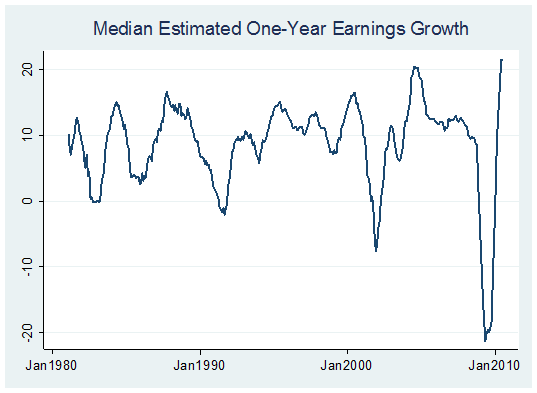
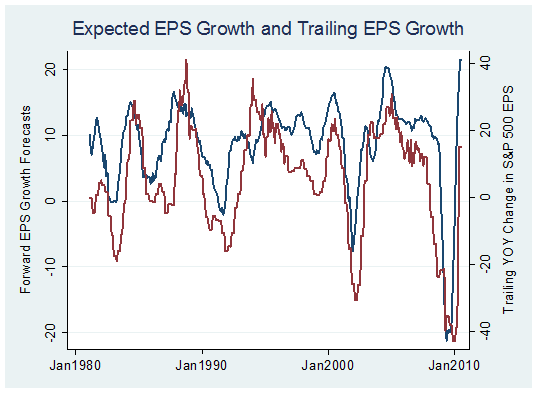
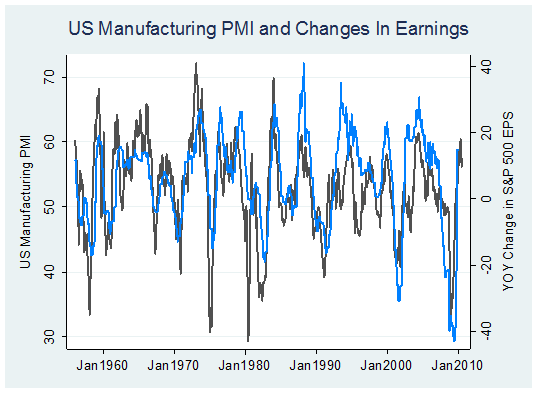
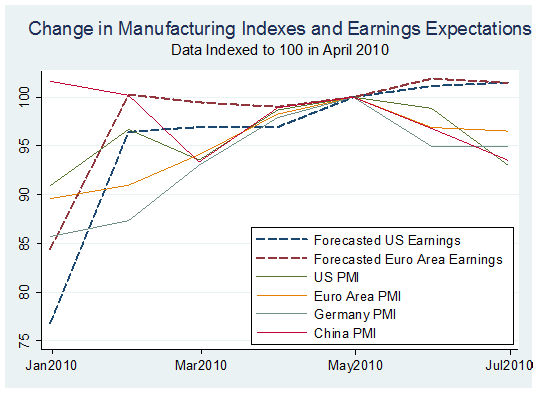
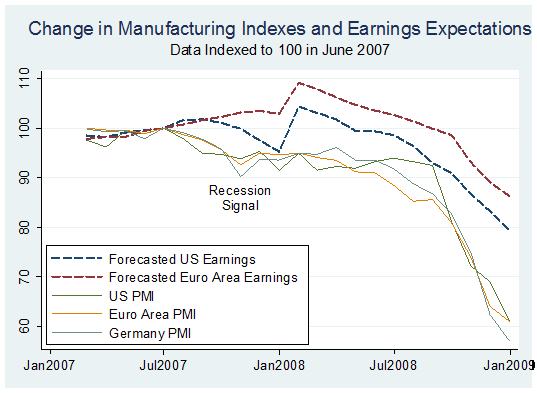
Monday, May 18, 2009
Q1 Earnings Not Such a Pretty Picture After All
from Zero Hedge:
As for U.S. consumers, headwinds may still be under-appreciated. Notices of Default (which precede foreclosures) are surging, counter-cyclical municipal tax and spending policies will be widely felt, and issuance of new credit cards (closely tied to retail sales) are falling off a cliff. Perhaps that's why bank credit card losses are already running close to the Fed's Adverse Case. There's also the issue of "Income Quality". Households are seeing escalating contributions from government transfer payments, rather than earned income (2nd chart). It does not take an economics degree to consider these transfer payments ephemeral, and something that will have to be paid for one day. The current savings rates have a long upward march from here.

Earnings Normalized -- NOT!
from The Big Picture blog:
I am becoming terribly enamored of the charts Ron Griess highlights each week form The Chart Store. Now that earnings season is all but over, Ron looks at a few charts that are revealing of the extent of the damage done to corporate profitability. It is, in a word, breathtaking:>
How Cheap Are Stocks?
>
How Much Have Profits Fallen?
Friday, April 17, 2009
More Big Bank Accounting Shenanigans
from Bloomberg:
Citigroup posted a $2.5 billion gain because of an accounting change adopted in 2007. Under the rule, companies are allowed to record any declines in the market value of their own debt as an unrealized gain.
Accounting Changes
The rule reflects the possibility that a company could buy back its own debt at a discount, which under traditional accounting methods would result in a profit. Critics say a company in distress is unlikely to realize the gains, and would have to reverse them eventually if it recovers.
Such reversals probably contributed to a first-quarter loss at New York-based Morgan Stanley, the Wall Street Journal reported April 8.
Citigroup, one of 19 U.S. banks gearing up for the release of “stress tests” run by the Federal Reserve, has quadrupled on the New York Stock Exchange since falling to an all-time low of $1.02 on March 5, in the wake of the company’s announcement that as much as $52.5 billion of preferred stock would be exchanged for common shares to bolster the bank’s equity base.
from NYT:
Goldman’s explanations sometimes do not ring true, even if they are. When it announced its profits this week, it buried an important fact in the tables on page 10 of a news release, and did not mention it in the text of the release. That fact was that Goldman had lost a lot of money in December, which would have been part of the quarter had the firm not changed its fiscal year. As a result, that loss does not show up in any quarterly number. Goldman won’t say if a December-to-February quarter would have been profitable.
Was Goldman’s disclosure misleading? Legally, no. There was full disclosure. But the existence of the orphan month, with its big loss, was largely overlooked in the initial news stories. When it was reported later, Goldman was left looking as if it had tried to pull a fast one.
Monday, April 6, 2009
Earnings from Banks May Bring Swift End to Stock Rally
from Bloomberg:
Investors are depending on banks more than at any time in at least 60 years to lead the U.S. out of the longest earnings slump since the Great Depression.
American companies will end more than two years of declining income by the fourth quarter, according to analyst forecasts compiled by Bloomberg. Banks will be responsible for all of the 76 percent rebound in the final three months of the year, because without financial companies, the gain turns into a 4.5 percent decline, the data show.
Rathbone Brothers Plc, MFS Investment Management and TD Ameritrade Holding Corp. say the reliance on banks is making them increasingly concerned that the 25 percent gain by the Standard & Poor’s 500 Index since March 9, the steepest rally since 1938, will dissipate. While rising home sales and durable- goods orders show the economy may be bottoming, unemployment and consumer debt as well as prospects that banks will be forced to write down more loans may halt the gain in equities.
Thursday, January 8, 2009
Earnings (Disappointment) and Lay-Off Season
The Dow is down another 50 points at this writing, and both Eurozone and Asian stock markets are down almost across the board. (So are my beloved grain futures.)
David Calloway wrote this prescient editorial on Marketwatch:
Read his entire commentary here. He says now, "the great dying begins"."Everybody should have known the holidays would only delay it. The freight train of job cuts, plunging earnings and massive spending cutbacks set to hit the economy was, thankfully, pushed back a few weeks while stunned investors and workers across the globe caught their breath after the worst fourth quarter in decades.
"...Earnings season, the time for companies to 'fess up just how bad it's been for them in the last three months, is here."
Here is the entire story.Stocks in Europe and Asia dropped, sending the MSCI World Index lower for a second day, on concern the deepening economic slump is wiping out earnings growth and demand for commodities. U.S. index futures declined.






